Latest
Latest News
Latest News
Latest News
Blog
The drug war is everywhere, even in my mailbox...
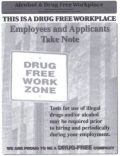 |
|
DRUG FREE WORKPLACE All employers should provide a Drug-Free Workplace program including a written policy statement. If an employee receives a positive confirmed drug test for illegal use of drugs or alcohol, or refuses to submit to drug or alcohol test, then the burden of proof is shifted to the employee. Substance abusing workers are:This "data," if you can call it that, is problematic in a number of ways. First, there is no differentiation of use from abuse, no explanation of what exactly is meant by abuse, no clarity as to whether the numbers refer only to illegal drugs or if they also include alcohol. If they do include alcohol, is there some distinction between casual use and heavier use that can affect work performance? Presumably the alcohol tests they mention would not have the same kinds of standards as illegal drug tests, since there is no legal or prevailing cultural standard calling for teetotalism (abstention from alcohol use). It is really hard to say exactly what they are saying. What we do know, however, is that drug testing isn't worth the money or the collateral costs. According to the 1994 National Academy of Sciences report "Under the Influence: Drugs and the American Work Force" (as summarized by the ACLU):
- Five times more likely to file a worker's compensation claim;
- 3.6 times more likely to be involved in on-the-job accidents; and
- Late for work three times as often.
- Absenteeism: Substance abusers are 2.5 times more likely to be absent 8 or more days a year.
- Lost Productivity: Substance abusers are one-third less productive.
Needless to say, at DRCNet we consider our staff's personal choices about substances to be their personal choices, and we have no intention of instituting such a program -- our people know that if they show up to work sober, get their work done and don't create risk for the organization by carrying contraband into the office, they'll be okay. Isn't that the way it should be, anywhere? This company is called The Labor Law Poster Service, located in Lansing, Michigan. I don't think we'll be ordering from them again. If there are any employers out there reading this who can point us to another such outfit, one that has the labor law posters we need but does not attempt to profit from the drug testing scam, please drop me a line before next year. Otherwise, we may just have to find all the different forms we need separately and cobble them together here ourselves. The drug war is everywhere...
- Research results indicate that drug use does not pose significant productivity or safety problems in the work force. In 1994, the National Academy of Sciences published results from a three year research effort compiling research resulting from all major studies of drug testing program effectiveness. The report concluded, "the data... do not provide clear evidence of the deleterious effects of drugs other than alcohol on safety and other job performance indicators."
- Though frequently inaccurate and ineffective, drug testing is extremely expensive. Texas Intruments reports that their drug testing program costs $100 per employee. Drug testing products and services are a multi-billion dollar industry. But the incidence of drug use in the workforce is very low. The federal government reported in 1990 that only 0.5% of tested employees tested positive. The same year, the government spent $11.7 million on its drug testing program. That works out to $77,000 per identified drug user.
- The NAS looked for and was unable to find evidence of drug testing programs' deterrent effects. Studies which appear to show a decrease in positive test rates since the implementation of drug testing programs usually don't adjust for the expansion of such programs' testing groups to include not only for-cause drug tests but also suspicionless drug tests. That is, as drug-testing programs have expanded, they have tested more and more people who aren't suspected of drug use, improving their numbers and subjecting thousands of non-users to invasive testing procedures.
Latest News
Latest News
Blog
Treating Drug Addiction With Addictive Drugs
Jacob Sullum at Reason is incredulous over a new Vancouver program that administers maintenance doses to stimulant addicts:
As long as legalization is out of the picture, taxpayers must choose between subsidizing the addictions of sometimes unsympathetic characters, or subsidizing by default the black market profiteers who would otherwise provide for them.
Anyone who canât come to terms with this will love Joe Biden's hilariously unworkable plan to eradicate drugs from the earth with biological weapons.
The government drives [stimulants] into the black market and then allows the select few who are sufficiently f#@ked up to get oral stimulants at taxpayers' expense. Meanwhile, doctors commonly prescribe stimulants to people who have trouble focusing and paying attention, a condition that used to be self-treated but nowadays is recognized as a disease requiring professional diagnosis. If you take these drugs without that diagnosis, you also have a diseaseâdrug dependenceâthat one day, if we're lucky, may be treated by giving you the drugs.The whole thing is mind-numbingly absurd. Try as we might to rein them in, drug policies continue to boldly defy the boundaries of logic at every turn. Still, Sullum's assessment of government sponsored maintenance programs gives me pause.
This strikes me as exactly the wrong way to achieve drug policy reform, guaranteed to alienate people who might be willing to let others use drugs but don't want to pick up the tab for it. The message should be freedom coupled with responsibility, not government-subsidized drug addiction.I'm not saying he's wrong, but I sure hope he is. Though ideal, the freedom/responsibility model isn't exactly resonating either. To whatever extent such programs are bad because they piss off taxpayers, one hopes they'll earn their keep by mitigating the destructive conditions that necessitate counterintuitive ideas like stimulant maintenance in the first place. Demonstrating that such programs actually save money while reducing harm should eventually placate reasonable skeptics.
As long as legalization is out of the picture, taxpayers must choose between subsidizing the addictions of sometimes unsympathetic characters, or subsidizing by default the black market profiteers who would otherwise provide for them.
Anyone who canât come to terms with this will love Joe Biden's hilariously unworkable plan to eradicate drugs from the earth with biological weapons.
Chronicle
Medical Marijuana: Flint Becomes Fifth Michigan City to Okay It
In a Tuesday election, voters in Flint, Michigan, approved the medical use of marijuana by a very comfortable margin.
Chronicle
Collision Course: Bolivia's "Coca, Si; Cocaine, No" Policy Runs Afoul of the International Drug Control Board and, Probably, the United States
With the release of its annual report this week, the International Narcotics Control Board has set its sights on Bolivia and that country's pro-coca policies. The US is also preparing to make a decision on whether to decertify Bolivia as not cooperating in American drug war goals. The Bolivians don't seem to care.
Chronicle
Chronicle on the Scene Feature: In the Bolivian Chapare, Evo Morales' "Coca, Si; Cocaine No" Policy Brings Peace, If Not Prosperity
The "coca, si; cocaine, no" policy of Bolivian President Evo Morales has brought peace to a region long riven by conflict and repression. But while coca farmers need no longer worry about violent conflict with the state, they are still having a hard time making enough money to survive. Plans are underway to do something about that.
Latest News
Chronicle
Free Speech: "Bong Hits 4 Jesus" Case Heading to Supreme Court Next Month, with Ken Starr Supporting One Side and SSDP Another
The court that not so long ago heard a case brought by Anna Nicole Smith will soon rule on whether students using the phrase "Bong Hits 4 Jesus" are entitled to 1st Amendment protection. The stakes are a lot more serious than the bizarre title may suggest.
Latest News
Chronicle
Latin America: Killing of Salvadoran Politicians By Police in Guatemala Opens Window on Drug Corruption in Central America, Killing of Killers Closes It
Three Salvadoran politicians were brutally murdered by Guatemalan anti-drug police outside Guatemala City 10 days ago. Now, the police killers have themselves been killed in a brazen assassination while being held inside a nasty Guatemalan prison. Many questions are being raised, but dead men tell no tales.
Latest News
Blog
many pictures from the Chapare...
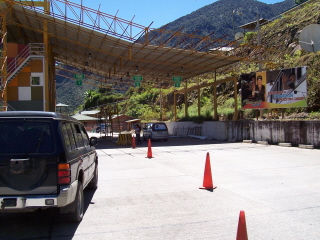 US-funded FELCN (Special Force for the Struggle Against Narcotics) checkpoint between Cochabamba and Chapare, search being conducted for cocaine and precursors
US-funded FELCN (Special Force for the Struggle Against Narcotics) checkpoint between Cochabamba and Chapare, search being conducted for cocaine and precursors
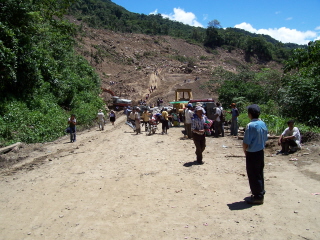 Site of major landslide produced by massive rainstorms. Buses and trucks by the dozens were backed up here. We had to leave the jeep on the near side, walk across the landslide, hire motorcyclists to carry us about a mile to where taxis were waiting, then hire a taxi for the afternoon in the Chapare.
Click the "read full post" link or here for 20 more pictures chronicling Phil's visit to the Chapare coca-growing region.
Site of major landslide produced by massive rainstorms. Buses and trucks by the dozens were backed up here. We had to leave the jeep on the near side, walk across the landslide, hire motorcyclists to carry us about a mile to where taxis were waiting, then hire a taxi for the afternoon in the Chapare.
Click the "read full post" link or here for 20 more pictures chronicling Phil's visit to the Chapare coca-growing region.Blog
Vermont Mayor Says Execute Drug Dealers, Legalize Marijuana
The increasingly obvious failure of the drug war is spawning some odd discussions this year. There's Joe Biden and Dan Burton calling for biological warfare in South America. There's a crazy former DEA agent promising a one-year turnaround if we bust all the "druggies" and force them to stop partying. Lou Dobbs is really frustrated too, and someone should talk to him before he starts racially profiling people and asking for consent to search.
But the prize might go to Barre, VT Mayor Thomas Lauzon who wants to try some of everything. From The Times Argus:
Expect to hear plenty more crazy talk of executing drug dealers and such this year. And don't be surprised to see more politicians calling for marijuana policy reform. The failure of the drug war is all around us and people are talking about it, for better or worse.
The drug war isnât going to start working one day. Inevitably, the road to reform will be paved with crazy idiots. If they want to legalize marijuana and execute crack dealers, we'll help with the former and talk them out of killing people later.
But the prize might go to Barre, VT Mayor Thomas Lauzon who wants to try some of everything. From The Times Argus:
BARRE â Mayor Thomas Lauzon on Saturday said he hoped the Legislature would consider imposing the death penalty on convicted crack and heroin dealers, and to legalize marijuana.Sounds like an episode of South Park. If the citizens of Vermont indulge him, this could be a highly entertaining public forum. For my money, Vermont is much more likely to legalize marijuana than execute anyone (they havenât imposed the death penalty in 50 years).
Failing that, the mayor said, he would call for a public forum in Barre to kick off a statewide discussion about the growing drug problem in Vermont and steps â including the death penalty and legalization â to control the situation.
Expect to hear plenty more crazy talk of executing drug dealers and such this year. And don't be surprised to see more politicians calling for marijuana policy reform. The failure of the drug war is all around us and people are talking about it, for better or worse.
The drug war isnât going to start working one day. Inevitably, the road to reform will be paved with crazy idiots. If they want to legalize marijuana and execute crack dealers, we'll help with the former and talk them out of killing people later.
Blog
Back from the Chapare
I'm now back from the coca producing region of the Chapare. Yesterday was a real grind: Get up very early, fly from La Paz to Cochabamba, take a taxi to the Andean Information Network office where I met up with AIN's Kathryn Ledebur and her husband, former Chapare human rights ombudsman ("defensor del pueblo) Gotofredo Reinecke, hopped in his jeep with him, stopped for gas and coca leaves (it's a tiring journey), then drove about two hours over an 11,000-foot mountain pass and down into the jungly Chapare.
But first, we had to traverse a major landslide on the highway caused by incessant rains. (We were extremely fortunate to have a mostly sunny day, a rarity this rainy season). At the landslide, buses and cargo trucks were backed up by the dozens, as they had been for days. The smell of rotting fruit in the trucks was pervasive. Bus passengers had to gather their bags and make a mile-long trek over a muddy path to get to buses waiting on the other side, but we left the jeep on the near side and walked right down the roadway itselfâa shortcutâafter Godofredo explained to the soldiers that I was a photojournalist shooting the "derrumbe." My sandals, socks, and jeans were covered with mud (which made quite an impression at the Cochabamba airport this morning). Once across the washed out area, it was onto the backs of small motorcycles for hire for another half-mile to where the buses and taxis were waiting for travelers trying to continue their journey, and then we hired a taxi for the tour of the Chapare.
In the miserably hot and humid lowlands, we stopped for lunch, where Godofredo spotted veteran newspaper vendor and scene-observer Don Jaime Balderrama, with whom we had an interesting chat. Then it was on to the local military base for a talk with the comandante, which proved absolutely fruitless. He refused to say a word of substance, saying it all had to be cleared with the military high command. Sadly, this seems to be the attitude throughout the Morales government when it comes to coca matters, and as a result, I am not making much progress in getting interviews with government officials (although I still have some feelers out and some hopes, fading as they may be). The army fort, bought and paid for by US tax dollars was nicely constructed, and the colonel's office featured the only air conditioning I ran across on the whole trip. Sweet for him. Sweet for us, too. I didnât want to leave, even though we were getting nothing from him.
Then it was on to visit Vitalia Merida, a former coca grower union leader (and current member), who has a coca field way out in the middle of nowhere. After her family suffered during the repression of the forced eradication years, she now reports that there is peace, if not prosperity. I'll be writing about what she had to say in a feature article this week. I have to say that is was an absolutely brutal hike in the mid-day sun to her coca patch. When I complained, Vitalia said, "You see how we suffer," although she sweated not a drop.
Next was Shinahota, a small town that was the center of the Chapare cocaine economy during the Wild West days of the "cocaine coup" back in the early 1980s. Main street there features a bunch of two-story buildings erected at that time. Downstairs you bought cocaine, guns, and luxury items; upstairs you rented prostitutes. It's much quieter these days, and much less profitable.
Just outside Shinahota, we stopped at a coca leaf warehouse operated by the local growers' union and had a nice chat with some Six Federation leaders who, sadly, were camera shy, and just a little bit suspicious of this wild-looking gringo. (I was indeed wild-looking by then: mud-splattered, sweat-drenched, my hair blown into knots as I hung my head out the window of the taxi seeking relief). We had an interesting conversation, though, and I will report on that in the Chronicle, too.
Between Shinahota and Villa Tunari, we stopped briefly at a new coca leaf processing plant, which is being financed by Venezuelan President Hugo Chavez. He has promised to import coca products to Venezuela, which would violate the UN Single Convention, but as AIN's Kathy Ledebur noted, "Who's going to stop him?" No one there but construction workers, though. Shortly past the new coca plant, in Villa Tunari, is a municipal hospital staffed primarily by dozens of Cuban doctors and nurses. I couldnât help but compare and contrast: The US builds forts and supplies the military, Venezuela helps Bolivia industrialize coca, and the Cubans heal the sick. So it goes.
That's my report for today. I now have in essence a day and half left in Bolivia. I'm attempting to line up some last interviews, but I'm a little depressed by my lack of success with government functionaries, and just bad luck with some other people I hoped to talk to. But I still have 36 hours...
More pictures will be posted here later today.
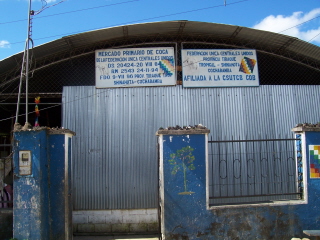 |
|
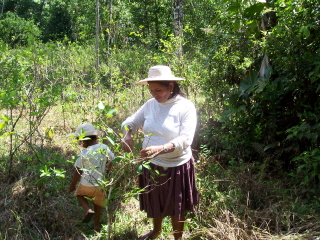 |
|
Latest News
Pagination
- First page
- Previous page
- …
- 1208
- 1209
- 1210
- 1211
- 1212
- …
- Next page
- Last page